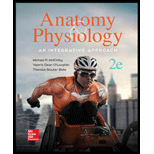
Anatomy & Physiology: An Integrative Approach
2nd Edition
ISBN: 9780078024283
Author: Michael McKinley Dr., Valerie O'Loughlin, Theresa Bidle
Publisher: McGraw-Hill Education
expand_more
expand_more
format_list_bulleted
Question
Chapter 12.11, Problem 33WDYL
Summary Introduction
To distinguish:
Difference between the reverberating circuit and a parallel after discharging circuit.
Concept introduction:
The central nervous system consists of interneuron, which is organized as neuronal pools. These neurons perform the same function even though their cell bodies are present in the different part of the central nervous system. Each pool of neuron receives an input from the part of other pool and generates an output. These neuronal pools may produce excitatory or an inhibitory effect on other neuronal pool.
Expert Solution & Answer
Want to see the full answer?
Check out a sample textbook solution
Students have asked these similar questions
What is the difference between a hyperpolarization and a depolarization?
What determines the size of a graded potential?
A. There is a lower resistance in the lower panel at the point where voltage is measured.
B. There is a greater capacitance in the lower panel at the point where voltage is measured.
C. The membrane voltage measured in the lower panel is farther away from the current pulse.
Chapter 12 Solutions
Anatomy & Physiology: An Integrative Approach
Ch. 12.1 - Prob. 1WDYLCh. 12.1 - What are the two primary functional divisions of...Ch. 12.2 - Prob. 3WDYLCh. 12.2 - Prob. 4WDYLCh. 12.2 - Prob. 5WDYLCh. 12.2 - Prob. 6WDYLCh. 12.2 - Prob. 7WDYLCh. 12.2 - What are the three connective tissue wrappings in...Ch. 12.3 - Prob. 9WDYLCh. 12.4 - If a person has a brain tumor, is it more likely...
Ch. 12.4 - Prob. 11WDYLCh. 12.4 - Prob. 12WDYLCh. 12.4 - Prob. 13WDYLCh. 12.5 - Prob. 14WDYLCh. 12.5 - Prob. 15WDYLCh. 12.6 - Prob. 16WDYLCh. 12.6 - Prob. 17WDYLCh. 12.7 - Prob. 18WDYLCh. 12.7 - Prob. 19WDYLCh. 12.7 - Prob. 20WDYLCh. 12.8 - How are EPSP and IPSP graded potentials...Ch. 12.8 - Prob. 22WDYLCh. 12.8 - How does depolarization and repolarization occur...Ch. 12.8 - Prob. 24WDYLCh. 12.8 - Prob. 25WDYLCh. 12.9 - Prob. 26WDYLCh. 12.9 - Prob. 27WDYLCh. 12.9 - Prob. 28WDYLCh. 12.9 - Prob. 29WDYLCh. 12.10 - Prob. 30WDYLCh. 12.10 - Prob. 31WDYLCh. 12.11 - Prob. 32WDYLCh. 12.11 - Prob. 33WDYLCh. 12 - _____ 1. The cell body of a neuron does all of the...Ch. 12 - Prob. 2DYKBCh. 12 - Prob. 3DYKBCh. 12 - Prob. 4DYKBCh. 12 - Prob. 5DYKBCh. 12 - Prob. 6DYKBCh. 12 - _____ 7. An action potential is generated when...Ch. 12 - Prob. 8DYKBCh. 12 - Prob. 9DYKBCh. 12 - Prob. 10DYKBCh. 12 - What are the four structural types of neurons? How...Ch. 12 - Prob. 12DYKBCh. 12 - How does myelination differ between the CNS and...Ch. 12 - Describe the procedure by which a PNS axon may...Ch. 12 - Prob. 15DYKBCh. 12 - Prob. 16DYKBCh. 12 - Explain summation of EPSPs and IPSPs and the...Ch. 12 - Graph and explain the events associated with an...Ch. 12 - Prob. 19DYKBCh. 12 - Prob. 20DYKBCh. 12 - Prob. 1CALCh. 12 - Prob. 2CALCh. 12 - Prob. 3CALCh. 12 - Prob. 4CALCh. 12 - Sarah wants to call her new friend Julie and needs...Ch. 12 - Over a period of 6 to 9 months, Marianne began to...Ch. 12 - Prob. 2CSLCh. 12 - Prob. 3CSL
Knowledge Booster
Similar questions
- What does it mean to say a local potential is graded, decremental,and reversible?arrow_forwardWhat is a depolarizing graded potential?arrow_forwardBased on the graph, the threshold voltage appears to be approximately. (Base your answer to this question on the graph below depicting an action potential.) +60 mV. +30 mV. 0 mV. −30 mV. −60 mV.arrow_forward
- When performing respiratory impedance plethysmography, two coils of insulated wire are sewn into elastic cloth bands in a sinusoidal manner. Over what are(s) of the body are the sinusoidal bands placed?arrow_forwardWhich of the following voltages would most likely bemeasured during the relative refractory period?a. +30 mVb. 0 mVc. -45 mVd. -80 mvarrow_forwardHow does Ohm’s law explain the passive moment of current down an axon?arrow_forward
- which of the following would be true (more than one can be true)? a) summation of A and X would reach threshold b) summation of C and A would be a graded potential c) stimulation by A would depolarize cell d) stimulation by B would be a subthreshold depolarization e) summation of B and C would be a graded potential with the net value of 12 mV depolarizationarrow_forwardWhat is the threshold potential?arrow_forwardPatch clamp recording of a single ion channel yields the following results: Holding Potential (mV) Measured Current (pA) -100 -1.0 -50 0.0 0 +1.0 +50 +2.0 +100 +3.0 Part a. What is the equilibrium potential for ion X+1? a.) 0 mv b.)+55 mv c.)-50 mv d.) -60 mv e.) -75 mv Part b. Is ion X+1 in higher concentration inside or outside the cell? a.) inside b.) outside Part c. Calculate the membrane potential at the instant when a neuron has the following relative permeabilities: PK+ = 1.0, PNa+ = 1.0, PCl- = 1.0. Use the ionic concentration values in the picture included. a.) -12 mv b.) -35mv c.) -60 mv d.) +20 mv e.) 0 mvarrow_forward
arrow_back_ios
arrow_forward_ios
Recommended textbooks for you
 Principles Of Radiographic Imaging: An Art And A ...Health & NutritionISBN:9781337711067Author:Richard R. Carlton, Arlene M. Adler, Vesna BalacPublisher:Cengage Learning
Principles Of Radiographic Imaging: An Art And A ...Health & NutritionISBN:9781337711067Author:Richard R. Carlton, Arlene M. Adler, Vesna BalacPublisher:Cengage Learning

Principles Of Radiographic Imaging: An Art And A ...
Health & Nutrition
ISBN:9781337711067
Author:Richard R. Carlton, Arlene M. Adler, Vesna Balac
Publisher:Cengage Learning
